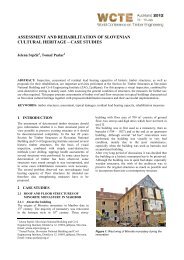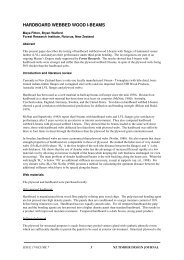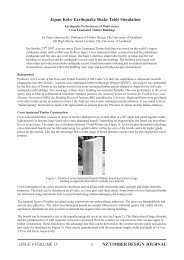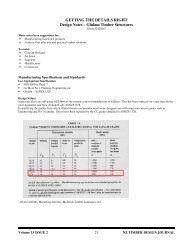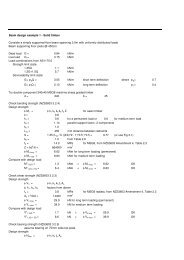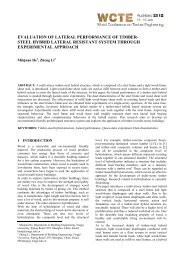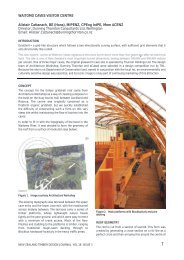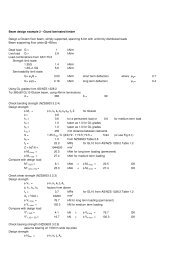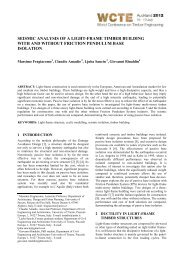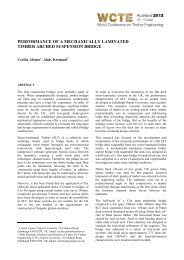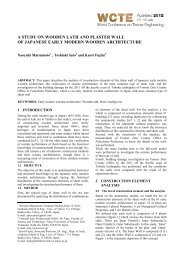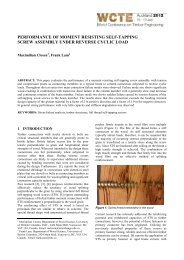00694 Pouyan Zarnani - Timber Design Society
00694 Pouyan Zarnani - Timber Design Society
00694 Pouyan Zarnani - Timber Design Society
Create successful ePaper yourself
Turn your PDF publications into a flip-book with our unique Google optimized e-Paper software.
ittle failure mode had better predictions in comparison<br />
to the ones from the Canadian code.<br />
P w = min (P a , P b , P c ), P i = 0.2 f t,k + 0.2 f v,k (3)<br />
(a) (b) (c)<br />
Figure 1: Proposed wood failure modes by Stahl (2004)<br />
1.3 MOTIVATION<br />
In the models which have been proposed for the wood<br />
strength so far, the minimum, maximum or the<br />
summation of the tensile and shear capacities of the<br />
failed wood block resisting planes is considered as the<br />
wood strength of the connection. These methods might<br />
not be appropriate since the stiffness in tensile and shear<br />
planes differs and this results in uneven load distribution<br />
amongst the resisting planes [1,7]. For instance, in a plug<br />
shear failure (Fig. 1a), the contribution of the bottom or<br />
lateral shear planes to the wood resistance cannot simply<br />
be considered as a function of their respective area as the<br />
connection load is not shared uniformly among the<br />
resisting planes due to the unequal stiffness of the<br />
adjacent wood. In the proposed analysis, the<br />
shortcomings of the existing predictive models are taken<br />
into account.<br />
2 NEW ANALYSIS FOR WOOD<br />
STRENGTH<br />
The proposed analysis for wood strength is based on a<br />
linear elastic spring system in which the applied load<br />
transfers from the main loaded wood block to the contact<br />
planes in conformity with the relative stiffness ratio of<br />
each resisting plane (Fig. 2). By predicting these<br />
stiffnesses, the contribution of each plane to lateral<br />
resistance and finally the ultimate load that cause brittle<br />
failure on these planes can be derived.<br />
Head<br />
tensile plane - h<br />
Bottom<br />
shear plane - b<br />
Lateral<br />
shear planes - l<br />
Figure 2: Proposed elastic spring model<br />
The difference in the stiffness of the tensile and shear<br />
planes is a function of the differences between the<br />
modulus of elasticity and modulus of rigidity, the wood<br />
surrounding the loaded block (bottom, end and edge<br />
distances-d z , d a and d e ) and also the connection<br />
geometry.<br />
2.1 HEAD TENSILE PLANE STIFFNESS<br />
In the rivet connection, the load is transferred from the<br />
plate to the wood block through the rivets. The load<br />
which applied to the wood increases as it reaches the<br />
head of the joint (Fig. 3). The load distribution in the<br />
row of rivets is assumed to be linear. Johnsson and Stehn<br />
P w<br />
K h<br />
K b<br />
P w<br />
Main loaded<br />
block<br />
K l<br />
P h P b P l<br />
Δ<br />
[7], using a load distribution model based on a spring<br />
system, showed that the maximum variation from the<br />
linear assumption, on the distributed loads among<br />
fasteners in a nail connection with 10 nails in a row<br />
before yielding was approximately 12%. The head<br />
tensile plane stiffness can then be derived by considering<br />
the tensile deformation of the loaded block, Δ, which is<br />
given by<br />
L<br />
<br />
EA ( N<br />
(4)<br />
where E is the modulus of elasticity, L is the length<br />
subjected to the tensile stress and A th the area subjected<br />
to the tensile stress at the head of the block. Thus, the<br />
average tensile stiffness for the head plane would be<br />
K<br />
h<br />
th<br />
2EA<br />
<br />
L<br />
th<br />
C<br />
(5)<br />
These equations use the connection geometry variables<br />
shown in Figure 4 and all dimensions are in mm.<br />
Figure 3: Simplified analytical model<br />
2.2 BOTTOM SHEAR PLANE STIFFNESS<br />
By developing an FE model, Foschi and Longworth [2]<br />
studied the effect of the bottom distance d z on the bottom<br />
plane shear stress. They observed that the shear stresses<br />
vary when d z is less than 2 times the rivet penetration, L p .<br />
They considered L p as the thickness of the failed block,<br />
t ef . This observation is applied when considering the<br />
effective depth of the wood bottom block in contact with<br />
the main loaded block in order to simplify the model<br />
(Fig. 3) to estimate the distortion of the bottom block<br />
which is considered fixed at the bottom edge and is<br />
subjected to shear stress on the top surface. Dividing the<br />
sum of the bottom shear forces P b by the total area over<br />
which they act A sb defines the average shear stress τ sb :<br />
<br />
Fixed<br />
edge<br />
sb<br />
Pb<br />
<br />
A<br />
sb<br />
in which G is the modulus of rigidity, γ sb the shear strain<br />
and X b the maximum effective depth of the bottom block<br />
defined as X b =2t ef . Thus, the average pure shear stiffness<br />
would be K GA X .<br />
sb<br />
1)<br />
Nc<br />
1<br />
Ph<br />
i<br />
<br />
i1<br />
NC<br />
<br />
<br />
sbG<br />
G<br />
X<br />
sb<br />
b<br />
b<br />
Ph<br />
L<br />
<br />
2EA<br />
da<br />
P l<br />
P<br />
Main loaded<br />
L<br />
t<br />
P h block<br />
ef<br />
P b<br />
P b<br />
X b=2t ef<br />
d z ≥ X b<br />
In contact<br />
bottom block<br />
Tensile force<br />
distribution<br />
L<br />
da<br />
However, as it is shown in Figure 3, the bottom block<br />
has a fixed edge at its head on its entire cross section<br />
which increases the stiffness and prevents deformation<br />
under the applied shear force.<br />
th<br />
X b<br />
Bottom block<br />
Fixed edge<br />
Shear force<br />
distribution<br />
(6)



